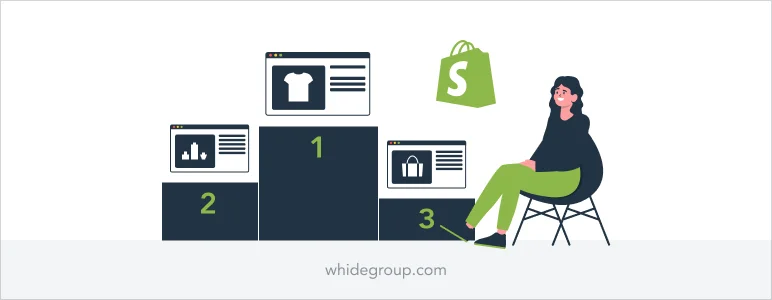What is Shopify and How Does it Work?
[A Beginner's Guide - 2025]
![What is Shopify and How Does it Work? [A Beginner’s Guide – 2025]](https://whidegroup.com/wp-content/uploads/shopify-tutorial-for-beginners-new.webp)
What is Shopify and How Does it Work?
[A Beginner's Guide - 2025]
Share post
Are you going to launch an online store? Understanding how Shopify works is a great first step. This platform is popular with many sellers due to its ease of use, no coding skills required, and wide range of features for ecommerce operations. Evidence?
As of early 2025, statistics show that approximately 5.5 million live online stores have been built using Shopify. This impressive figure gives Shopify a leading 3.5% market share among the top 1 million ecommerce stores. To put this in perspective, WooCommerce Checkout, the second-place contender, holds a 1.88% share — almost half of Shopify’s.
Ready to explore the basics of Shopify? This article will answer your key questions, including:
Let’s get started!

Table of Contents
ToggleShopify is a cloud-based ecommerce platform designed for businesses of all types and sizes. It provides a comprehensive suite of tools to create, manage, and grow an online store. This includes everything from hosting and website design to payment processing, shipping integrations, and marketing promotion.
By saying “businesses of all types” we actually mean it. Here’s the range of products and services offered within the Shopify admin panel:


Shopify operates on a Software-as-a-Service (SaaS) model. This means you subscribe to the platform rather than building and maintaining the underlying infrastructure yourself. Subscription fees cover hosting, security, and core functionalities, allowing you to focus on your business, not server maintenance.
So, what does Shopify do to solve the technical aspects of online selling? Here’s a simplified breakdown:
Before we dive into our step-by-step guide to creating your first Shopify store, let’s recap the key benefits that make Shopify a popular choice for individual online sellers and ecommerce businesses in 2025.
Now that you’re convinced that Shopify is the right platform for you, let’s move on to the main point of this article.
The following instruction details the process of creating a Shopify online store, answering key questions about how a Shopify store works.
Visit Shopify website and click the “Start free trial” button at the upper right corner. You can choose a convenient registration method, no credit card details are required at this stage.

You’ll then be asked a few questions about your business, which helps Shopify personalize your experience. However, these questions are optional, and you can skip them to proceed directly to your store setup.

Shopify will ask you to choose a subscription plan, but you can also do it later.

After the initial setup, you’ll be taken to your Shopify admin dashboard. From here, you can begin adding products and customizing your store’s design to match your brand. The intuitive interface and the helpful setup guide on the homepage make it easy to adjust your store’s appearance and settings.

Navigate to the “Products” section in your admin dashboard. Click “Add product” and fill in all the necessary details, including product title, description, images, pricing, inventory, and variations (if applicable).

Whidegroup tips:
Go to “Online Store > Themes”. Shopify offers a selection of free themes, or you can purchase premium themes from the Shopify Theme Store.

The store provides 13 free templates — each comes in two or three different variations, which actually means a pretty good selection of design options.
If you won’t find any of the free themes attractive you can use one of 225 paid premium themes (as already mentioned, each of them is presented in several styles). These themes range in price from $100 to $500, and as well as free themes, they are customizable.
Apart from the Shopify store, you can find hundreds of custom made templates on different resources like Templatemonster, where prices start from $39.
If you’re looking for a highly customized design to showcase your business and build a stronger brand, consider working with expert Shopify developers to create a theme from scratch.
Go to “Settings” in the bottom left corner of your admin dashboard.
Set up your payment gateway under “Payments”. Choose between Shopify Payments (recommended for simplicity) or integrate with third-party providers like PayPal.

Shopify Payments is Shopify’s integrated payment gateway. It offers a seamless way to manage all your store’s transactions directly within the Shopify platform. Its tight integration simplifies setup and streamlines your financial management.
Important: Besides the fact that Shopify Payments isn’t available in all countries, relying on it exclusively isn’t recommended. Based on ecommerce best practices and our experience, we advise researching popular payment methods in your target regions and offering customers a variety of convenient payment options. These might include Google Pay, Apple Pay, PayPal, Stripe, or other solutions tailored to local preferences.
Next, configure your Shopify shipping settings under “Shipping and delivery”. Set up shipping zones, rates, and carriers. Consider offering various shipping options to cater to different customer needs.
Shopify allows you to set the shipping rate for each region. If your store audience is localized, you can set up internal rates. If you sell and ship worldwide, then you can set rates for each country.

Visit the Shopify App Store to find apps that enhance your store’s functionality.

Thousands of available apps are divided into seven categories:

Many apps offer free trials, allowing you to test their functionality before committing to a paid plan. This lets you choose the apps that best meet your specific business needs.
Whidegroup tips:
Once you’ve configured your store settings, added products, and chosen a theme, it’s time to launch!
In your admin dashboard, go to “Settings > Domains”. Connect your existing domain or purchase a new one through Shopify.
It is important to note that you can create your store on the Shopify subdomain. In this case, you get a free domain, however your website URL will look something like “website-name.myshopify.com”. Of course, if you’re ok with that, you can just go with the subdomain. However, we tend to think that it is better to pay $15–$30/year and own a unique domain name.

Before going live, double-check all your settings, product listings, and payment gateways, then place a test order. Finally, make your store publicly accessible:
Without promotion, even the best products will struggle to find customers, so utilize Shopify’s marketing tools to reach your audience.
The marketing page on your admin panel provides a central hub for creating and managing marketing campaigns, automating key processes, and analyzing performance metrics.
Note: Marketing features require a Basic Shopify plan or higher and at least one installed marketing app.
Shopify allows you to create diverse advertising campaigns across four key areas:
Furthermore, you can leverage Shopify’s marketing tools to analyze campaign performance, automate various tasks (segmented newsletters, event-triggered emails, and ad updates across selected channels), and optimize key metrics like your store’s bounce rate.
If you want to reach a wider audience and increase your sales potential, Shopify offers integrations with platforms like Facebook and Instagram, Pinterest, and Google Shopping. Enable these sales channels in your Shopify admin dashboard to list your products and manage orders from different platforms.

Another important feature of Shopify, which sets it apart from most of its competitors is the complex POS option and its hardware.
Shopify POS extends your sales reach beyond the online realm, enabling you to sell in physical locations using a POS terminal. A wide range of compatible hardware, including barcode scanners and receipt printers, is also available.
Shopify POS is a versatile tool, ideal for various selling scenarios, such as pop-up shops, market stalls, events, and even traditional retail stores. At the same time, it flawlessly synchronizes your inventory and product availability across both online and offline channels.
Note: Full POS functionality requires the “Shopify” plan or a higher-tier subscription.
Shopify is an all-in-one SaaS platform that provides essential tools and services needed to sell online, eliminating the need for businesses to build an online store with all ecommerce infrastructure from scratch. This includes website design, hosting, payment and shipping integrations, SEO and marketing tools, and more.
Shopify provides the platform for you to create your own online store, giving you full control over your brand, customer relationships, and sales channels. Amazon, on the other hand, is a marketplace where you list your products alongside millions of others. You benefit from Amazon’s massive traffic, but you’re also subject to their rules, fees, and competition.
Definitely! Shopify is a good starting point. Its user-friendly interface, ready-made theme templates, and no-code setup make it accessible even without technical skills.
Yes. It offers a cost-effective way to establish a professional online presence without requiring a large upfront investment in development or infrastructure. Additionally, its scalable plans allow small businesses to start small and grow as their sales increase.
Users most often mention the following drawbacks:
While Shopify makes it easier to create an online store, it doesn’t guarantee success. Some Shopify stores fail due to common business challenges, not necessarily issues with the platform itself. For example, a lack of a clear business plan, poor customer service, a weak or nonexistent marketing strategy, pricing and profitability issues, and more. (Explore more about Why do Shopify Stores Fail)
Shopify is well-suited for a wide range of businesses. Here’s main examples:
Besides physical products, Shopify allows far more types of goods to be sold through the platform:
It can be used for service businesses, particularly those with relatively simple service offerings that can be packaged as “products”. However, it’s important to carefully consider the limitations and explore available apps or custom development options to ensure it meets your specific needs.
Of course, there is a list of products that are prohibited from sale. It mainly includes different types of firearms and certain related parts. You can find a specific list of such products on the official page.
Dropshipping is a business model in which you don’t store the products you sell. Basically, you take the order, send it to the supplier, who in turn packs and sends the product to the customer. Throughout this process, your store acts as an intermediary.
Shopify leads the market of dropshipping software providers. The platform offers a large selection of dropshipping apps that make it easy to find and sell products from various vendors.
Yes, you absolutely can make money on Shopify. However, while Shopify acts as a complex of tools for building, launching, and promoting your online business, your success will depend on several key factors, including product value and demand, brand positioning, marketing strategy, and competition within your business’s niche.
Shopify pricing is divided into various plans to cater to different business needs and budgets:
Shopify’s fees per sale depend on your plan and payment method. If you use Shopify Payments, aside from the credit card rate and the subscription fees for your store’s Shopify subscription plan, there are no monthly fees. If you use third-party payment gateways, Shopify charges an extra fee of 0.6% to 2%, depending on your plan.
The cost to start a Shopify store depends on your plan, products, and marketing budget. At a minimum, you’ll need:
These are the most obvious expenses you will face and they will start at an average of $100 to $500. Сustom design or third-party apps will increase the final bill.

Summing up on what Shopify is and how it works, we’d like to highlight that it has a simple interface, a bunch of necessary features, and comprehensive customer support. This suite of advantages is crowned with an affordable subscription cost, making Shopify an excellent option for beginners and small to mid-size businesses.
The best way for understanding Shopify is to create your own account yourself. Take advantage of the free trial to explore the platform and determine if it’s the right fit for your business needs.
Don’t want to spend weeks on research? Contact us and get the answer within a couple of days. Knowing the niche and size of your business we can save your time and assist you in making an informed decision.
Share This Article

 Top Jewelry Ecommerce Trends in 2025: What to Expect and Prepare For
Top Jewelry Ecommerce Trends in 2025: What to Expect and Prepare For